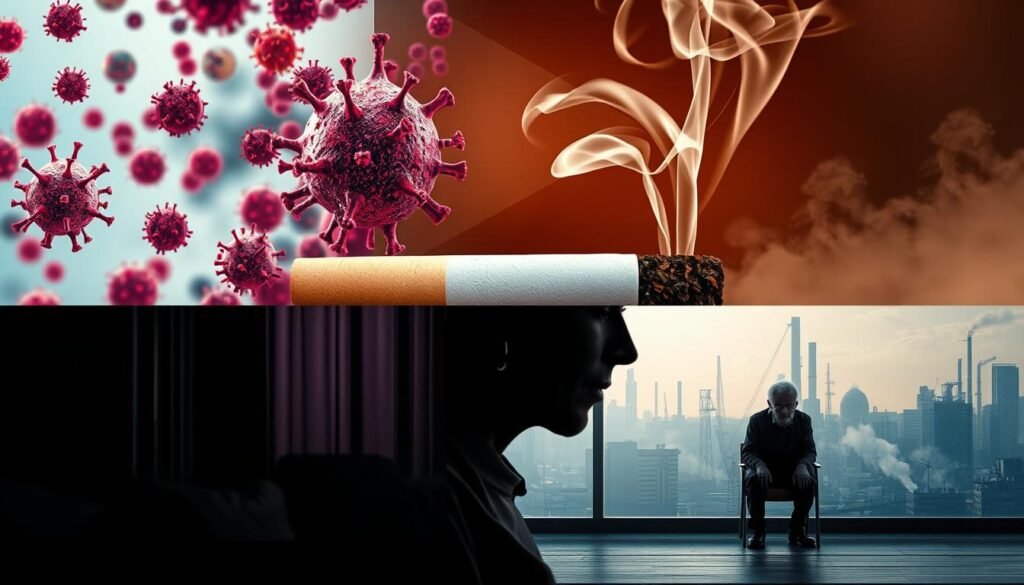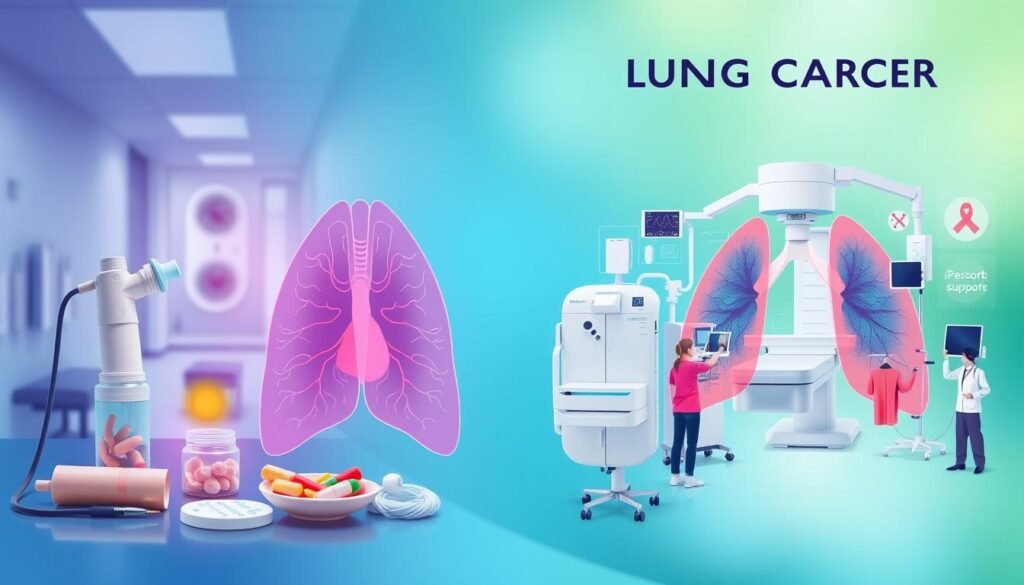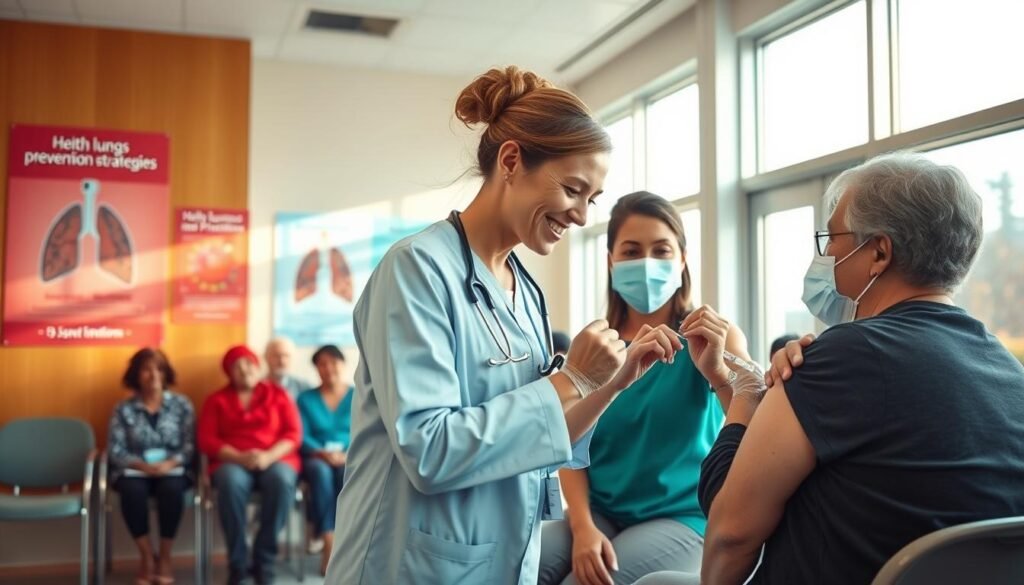Shockingly, about 70% of those with lung cancer will face pneumonia during their illness. This highlights the urgent need to know about pneumonia and its link to lung cancer. Millions in the US are affected by both, so it’s key to understand their connection for prevention and treatment.
Pneumonia inflames the air sacs in one or both lungs and can be caused by various pathogens. Lung cancer is the top cause of cancer deaths, mainly due to smoking. Those with lung cancer have a higher pneumonia risk because cancer treatments weaken their immune system. Knowing the symptoms of both pneumonia and lung cancer is crucial. This knowledge helps patients and caregivers manage these health issues better.
Key Takeaways
- Over half of lung cancer patients develop lung infections, including pneumonia.
- Smoking is the leading cause of lung cancer.
- Pneumonia can arise from various pathogens: bacteria, viruses, and fungi.
- Coughing is a shared symptom of both pneumonia and lung cancer.
- Vaccination against pneumonia and influenza is crucial for individuals with lung cancer.
- Good hygiene and avoiding lung irritants can help prevent pneumonia.
- Infections are the second most common cause of death in lung cancer patients.
Pneumonia: An Overview
Pneumonia is a lung infection that makes it hard to breathe because of fluid or pus. It can be caused by bacteria, viruses, or fungi. A 2015 study found it’s a leading cause of death from infection worldwide.
Many things can cause pneumonia, like the flu. One big cause, pneumococcal pneumonia, was behind 55% of related deaths. This means about 1.5 million people died from it. Pneumonia is grouped by where you get it: at home, in the hospital, or from a ventilator.
Getting pneumonia in the hospital is called hospital-acquired pneumonia (HAP). If you get it from being on a ventilator, it’s called ventilator-acquired pneumonia (VAP). Detecting pneumonia in people with weak immune systems is tough.
To treat pneumonia, doctors use antibiotics for bacterial types and antivirals for viral ones. Quick tests can now identify the cause fast. Having conditions like COPD or cancer raises your pneumonia risk.
Every year, pneumonia kills thousands in the U.S., especially those over 65 or under two. Weak immune systems make them more at risk. Smoking and having lung or heart problems also ups your risk.
Kicking off treatment for pneumonia right away is crucial. For detailed treatment info, check out this study.
What is Lung Cancer?
Lung cancer starts when lung cells grow out of control. It can form tumors and is a top cause of cancer deaths in the U.S. Smoking is the main cause, but other things also matter.
Long-term contact with harmful substances like radon and asbestos can cause lung cancer. People who had radiation therapy face a higher risk too. It’s important to know these causes to prevent and find the disease early.
There are several treatments for lung cancer, depending on its stage. Early-stage non-small cell lung cancer (NSCLC) might need surgery. Small cell lung cancer (SCLC) can also be treated if it’s small.
If the cancer is by the lung’s edge, radiofrequency ablation (RFA) is used. This method heats and kills the cancer cells.
Radiation therapy can shrink tumors or lessen pain on its own or with surgery. Chemotherapy stops cancer cells from growing. It’s used at different treatment times.
Targeted drug therapies work on certain NSCLC mutations. Immunotherapy helps the immune system fight cancer.
Dealing with lung cancer treatment can lead to nausea and tiredness. Managing these side effects can make life better. It’s key for patients and families to understand lung cancer, its causes, and treatments.
Understanding the Connection between Pneumonia and Lung Cancer
The link between pneumonia and lung cancer is both complex and significant. People with lung cancer are more prone to pneumonia. This is because their immune systems are weakened by the disease and its treatments. About 70% of lung cancer patients will face pneumonia or other lung infections.
Pneumonia can be a complication and a warning sign of lung cancer risk. Research shows that those with a history of pneumonia are more than three times likelier to get lung cancer. If someone often has pneumonia or bronchitis, it could mean they are at higher risk for lung cancer.
There are several lung cancer risk factors including smoking, which causes nearly 90% of lung cancer cases. People with chronic lung diseases like COPD are also more at risk of getting infections such as pneumonia. Lung cancer combined with pneumonia can have severe outcomes, making pneumonia a leading cause of death in lung cancer patients.
Dealing with lung cancer means keeping an eye on respiratory health. Getting vaccinated against pneumonia and the flu is very important. Doctors may also suggest certain treatments like antibiotics for bacterial pneumonia and corticosteroids to reduce inflammation. Early detection of lung cancer through low-dose CT scans can save lives, especially in people at high risk.
| Aspect | Pneumonia | Lung Cancer |
|---|---|---|
| Prevalence in Lung Cancer Patients | 70% | Leading cause of cancer death |
| Risk Factors | Smoking, Chronic Lung Diseases, Recent Infections | Smoking, Family History, Age |
| Treatment Options | Antibiotics, Corticosteroids | Surgery, Chemotherapy, Radiation, Targeted Therapy |
| Preventive Measures | Vaccination, Hygiene Practices | Quit Smoking, Regular Screening |
It’s critical to recognize the connection between pneumonia and lung cancer. Healthcare providers must watch lung cancer patients closely for signs of pneumonia. This ensures they get the thorough care they need, addressing the cancer and its complications together.
Common Symptoms of Pneumonia
Pneumonia symptoms are varied and can confuse people. It’s essential to get medical help fast. Bacterial pneumonia is a common type. It causes symptoms that should not be ignored. People with it often have a steady cough. This cough usually brings up thick mucus that is green or yellow. This can be a sign of a serious infection.
A high fever is another symptom that is seen a lot. It can go up to 105 degrees Fahrenheit with bacterial pneumonia. Many also have fast breathing and a quick heart rate. These show the body is fighting the infection. Viral pneumonia starts slower, with symptoms that look a lot like the flu.
Newborns and babies can be tough to diagnose with pneumonia. They might not show the usual signs but could vomit, have a fever, cough, or be restless. On the flip side, older people or those with weak immune systems might show fewer signs. This makes figuring out what they have harder. Sudden mental changes in older patients are especially worrisome.
It’s critical for people at high risk to get help if they notice pneumonia symptoms. This group includes older adults, very young children, and those with health issues. Doctors might do blood tests, chest X-rays, or other tests. For those at higher risk, more detailed tests like CT scans or a bronchoscopy might be needed. This helps confirm the diagnosis.
Each year, over three million cases of pneumonia are reported in the U.S. Over half a million of these need hospital care. Knowing these symptoms well is key. Catching pneumonia early can lead to better health results, especially for those at greater risk.
| Type of Pneumonia | Common Symptoms | Notes |
|---|---|---|
| Bacterial Pneumonia | Cough (thick mucus), fever, rapid breathing, chest pain | Fever can reach up to 105°F |
| Viral Pneumonia | Dry cough, fever, fatigue, body aches | Symptoms may develop slowly, similar to influenza |
| Infants and Newborns | Vomiting, fever, cough, restlessness | May not show typical signs of infection |
| Older Adults | Milder symptoms, potential change in mental awareness | Fewer and less obvious symptoms |
Symptoms of Lung Cancer: How They Differ
Lung cancer symptoms can be hard to spot early on. They might seem like common health issues. Here are some critical signs of lung cancer:
- Chronic cough: A cough that lasts more than eight weeks could be a sign.
- Shortness of breath: Tumors might make airways narrow, making breathing tough.
- Coughing up blood: If this happens, it’s crucial to see a doctor right away.
- Hoarseness: Your voice might change if a tumor affects your vocal cords.
- Chest pain: Tumors can press on nerves, causing pain when you breathe deeply or cough.
There are also general symptoms that might not seem related to lung cancer at first:
- Unexplained weight loss
- Fatigue and weakness
- Bone pain and headaches
- Lumps in the neck or collarbone area
- Swelling in the face, neck, or arms
- Jaundice (yellowing of the skin and eyes)
It’s important to know these signs. Lung cancer can look like other illnesses, like pneumonia. This makes early screening key, especially for those who smoke a lot.
Pneumonia Risk Factors and Causes
Pneumonia is a big health problem, leading to more than a million hospital stays every year in the US. Several things can raise your chance of getting it. Being very young or much older, like over 65, makes you more likely to catch pneumonia. People with chronic conditions such as diabetes or heart problems are also at higher risk. Likewise, if your immune system is weak from things like cancer treatments, you’re more vulnerable.
Environmental factors play a part in catching pneumonia too. If you’re often in crowded places or where there’s a lot of pollution or smoke, your risk goes up. Smoking or vaping is especially risky, making you much more likely to get this lung infection.
To prevent pneumonia, it’s super important to focus on strategies that help avoid it. Washing your hands regularly is a good start. Try to keep away from sick people. Regular exercise, getting enough sleep, and eating healthy also go a long way in keeping you safe from pneumonia.
The table below highlights some major things that increase pneumonia risk and ways to prevent it:
| Risk Factor | Pneumonia Prevention |
|---|---|
| Age (infants, seniors) | Vaccination, regular health screenings |
| Chronic Diseases (e.g., COPD, diabetes) | Manage chronic conditions and receive appropriate care |
| Weakened Immune System | Vaccinations, avoiding infections |
| Tobacco Use | Smoking cessation programs |
| Environment (crowded places, air pollution) | Avoiding pollution exposure; wearing masks if needed |

Knowing about pneumonia causes and taking steps to prevent it can save lives. By paying close attention to risk factors and taking action, you can greatly lower your chance of getting pneumonia.
Lung Cancer Causes and Risk Factors
Lung cancer is mainly caused by a few key factors, with smoking at the top. More than 60% of lung cancers in the UK come from tobacco use. To prevent lung cancer, starting with quitting smoking is crucial.
Being around harmful substances like radon gas and asbestos also raises your risks. A few lung cancers are linked to radon gas. Outdoor air pollution causes about 8% of lung cancer cases in the UK. People like bricklayers who work with silica dust face higher risks. It’s important for workers exposed to dangerous chemicals to get regular health screenings.
Genetics matter too. If lung cancer runs in your family, your risk might be higher. More than 80% of lung cancers are in people who smoke or used to smoke. How long and how much you’ve smoked affects your risk as a former smoker. Secondhand smoke can also lead to lung cancer in non-smokers.
Other illnesses like COPD and pneumonia add to lung cancer risks. Diseases like Idiopathic Pulmonary Fibrosis (IPF) increase your chances of getting lung cancer. Lowering these risks involves understanding lung cancer causes. It’s good to minimize contact with harmful substances and get regular check-ups. For more details on lung cancer causes, here’s a resource.
Pneumonia and Lung Cancer: Diagnosis and Treatment Options
Doctors start diagnosing pneumonia with a deep check-up. They often use chest X-rays to see inflammation in the lungs. They might do blood tests to check for infection. It’s key to treat pneumonia well to fight off bacterial infections. This usually means taking antibiotics and getting support care. Patients should stick to their treatment plan to get better.
Lung cancer diagnosis usually begins with imaging tests like X-rays, MRI, and CT scans. These tests find cancerous cells and figure out the cancer type. Treating lung cancer depends a lot on how severe the cancer is. Advanced tools, like PET scans, help doctors see where the cancer is and if it’s spread.
Lung cancer stages go from 1 to 4, showing how much the cancer has grown. Higher stages mean bigger tumors or wider spread. Treatment might include surgery, like removing part of the lung, depending on the tumor’s size and place.
Radiation therapy plays a big part in treating lung cancer. It’s used before or after surgery to target tumors or cancer cells left behind. Chemotherapy, which uses strong drugs, can also be used alone or with radiation. It depends on each patient’s situation.
For those who can’t have surgery, stereotactic body radiotherapy offers a way to precisely target small lung tumors. Newer treatments, like targeted therapy and immunotherapy, work by attacking cancer in specific ways or boosting the immune system to fight cancer.
Palliative care is also a vital part of treatment for lung cancer. It aims to ease symptoms and improve life quality for those living with the disease.
| Diagnosis | Pneumonia | Lung Cancer |
|---|---|---|
| Primary Tests | Physical examination, Chest X-rays, Blood tests | X-rays, MRI, CT scans, PET scans |
| Treatment Options | Antibiotics, Supportive care | Surgery, Radiation therapy, Chemotherapy, Targeted therapy, Immunotherapy |
| Stage Assessment | N/A | Staged 1 to 4 based on tumor size and spread |
| Supportive Care | N/A | Palliative care for symptom relief |

How to Prevent Pneumonia if You Have Lung Cancer
For those with lung cancer, pneumonia prevention is key. Getting vaccinated is important, such as the flu and pneumococcal shots. These vaccinations guard against infections that can worsen lung issues. Also, keeping hands clean is vital. People should wash their hands well, especially after visiting public places.
Stay away from crowded areas to lower infection risk. Keep distance from sick people and ensure a clean living space. This supports lung cancer prevention. Also, go for regular health check-ups. They help catch health problems early, which means better management.
A healthy lifestyle is very important. Eat well, stay active within your limits, and rest enough. These steps strengthen your immune system. They reduce pneumonia risk and help recover from cancer treatments.
If you’ve had surgery like abdominal operations, use incentive spirometers. They help your lungs expand and stop pneumonia from starting. Notice early symptoms like fever, cough, and breathing difficulty. Quick action can lead to better health results for those at risk.
For more information on preventing pneumonia, talk to healthcare experts. Knowing how to prevent it and acting on these health tips can help lung cancer patients enjoy better breathing health.
The Importance of Vaccination in Preventing Pneumonia
In 2020, pneumonia took more than 47,000 lives in the U.S. alone. It’s vital to have effective pneumonia prevention methods to lower these numbers. Vaccines are especially critical for people with weak immune systems, like those with lung cancer or chronic lung diseases.
Pneumococcal vaccines are 50 to 80 percent effective against serious invasive diseases. They are usually given to:
- Children under age 5
- Adults age 50 and older
- Individuals with specific health conditions at higher risk
In the U.S., four types of pneumococcal vaccines are available. Which one a person gets depends on their age, health, and vaccination history. High-risk individuals often get one vaccine shot before 65 and another at least five years apart.
Some conditions need extra attention for vaccination:
- Smoking
- Cancer
- HIV/AIDS
- Asplenia or immunocompromising conditions
- Chronic diseases, like kidney, liver, or heart disease
- Cochlear implants
- Alcoholism
- Asthma and other lung conditions
Talking to healthcare providers is important to pick the right vaccination plan. This includes people who don’t know their vaccination status. This is a key part of pneumonia prevention.
Pneumococcal vaccines can be given with flu and COVID-19 vaccines for better protection against respiratory infections. Around 3.37 million people get community-acquired pneumonia (CAP) each year. This includes those with chronic lung diseases. Vaccines help lessen the effects of such diseases.

Being knowledgeable and active about vaccinations lowers pneumonia risks in high-risk groups. Knowing how vaccines work shows how vital pneumonia prevention is for better health.
Conclusion
Understanding how pneumonia and lung cancer are connected is key for healthcare experts and patients. Studies suggest that having pneumonia might lower the chance of getting lung cancer. This is especially true for those who’ve had it more than once. Knowing the early signs and taking action quickly can make a big difference. For details on lung cancer signs check out this resource.
Pneumonia is a big problem for people with lung cancer, leading to more hospital stays and higher death rates. That’s why it’s crucial to prevent pneumonia and treat it effectively in lung cancer care. By knowing more about both conditions, people can make better health choices.
It’s vital to pay attention to the signs of both pneumonia and lung cancer. Research shows taking care of chronic bronchitis and avoiding pneumonia is helpful. Educating people about these health issues can lead to better health outcomes.